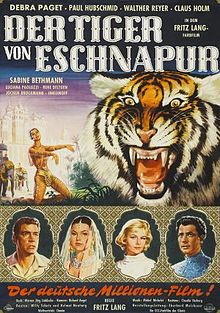- The Tiger of Eschnapur (1959 film)
-
The Tiger of Eschnapur 
German film posterDirected by Fritz Lang Produced by Artur Brauner Written by Fritz Lang
Werner Jörg Lüddecke
Thea von Harbou (novel)Starring Debra Paget
Paul Hubschmid
Walter ReyerMusic by Michel Michelet Cinematography Richard Angst Editing by Walter Wischniewsky Distributed by American International Pictures
Fantoma
Omnia-Film
Polyband GmbHRelease date(s) January 22, 1959 Running time 101 min. Country Germany Language German The Tiger of Eschnapur, or in original German, Der Tiger von Eschnapur, is a 1959 German adventure drama film directed by Fritz Lang. It is the first of two films comprising what has come to be known as Fritz Lang's Indian Epic; the other is The Indian Tomb (Das Indische Grabmal). Fritz Lang returned to Germany to direct these films, which together tell the story of a German architect, the Indian Maharahaja for whom he is building a temple, and the Eurasian dancer who comes between them.
Contents
Prior works
Lang's Indian epic is based on work he did forty years earlier on a silent version of Das Indische Grabmal. He and Thea von Harbou co-wrote the screenplay, basing it on von Harbou's novel of the same name. Lang was set to direct, but that job was taken from him and given to Joe May. Though Lang did not control the final form of that earlier version, it is one of his most revered films.
Released in 1921, the original version of Das Indische Grabmal had a running time of 31⁄2 hours. For the remake, Lang divided the story into two parts that each run about 100 minutes, a length modern audiences can more easily accept.
Plot
The tale begins when architect Harold Berger (Paul Hubschmid) arrives in India to meet with Maharahaja Chandra (Walter Reyer), for whom he will build a temple. En route to the Maharahaja's palace, Berger meets a dancer named Seetha (Debra Paget) and saves her from a tiger. Seetha is promised to the Maharahaja, but she and the architect begin to fall in love. Predictably, this leads to a buildup of tension between Chandra and Berger, helped along by scheming palace courtiers. The film is also filled with action, and a highlight of it is Seetha's first ritual dance. At the end of Tiger, Seetha and Berger are imprisoned but escape into the desert just as Berger's sister, also an architect, arrives with the team of architects hired to continue his work. Chandra informs her the plans have changed; she will now be building a tomb.
Cast
- Debra Paget as Seetha
- Paul Hubschmid as Harold Berger
- Walter Reyer as Chandra
- Claus Holm as Dr. Walter Rhode
- Luciana Paluzzi as Baharani
- Valéry Inkijinoff as Yama
- Sabine Bethmann as Irene Rodhe
- René Deltgen as Prince Ramigani
- Jochen Brockmann as Padhu
- Richard Lauffen as Browana
- Jochen Blume as Asagara
- Helmut Hildebrand as Ramigani's servant
- Guido Celano as General Dagh (uncredited)
- Victor Francen as Penitent (uncredited)
- Panos Papadopoulos as Kurier (uncredited)
- Angela Portaluri as Bäurin (uncredited)
Filming locations
This cliffhanger unfolds against a sweeping backdrop incorporating lavish but relatively spare and open sets, a trademark of Lang's work. He also made extensive use of on-location shots. Having lived for a number of years in India, he was able to get permission from the Maharana of Udaipur to shoot at many locations that were normally barred to Western film crews. One of these was the floating Lake Palace seen much later in Octopussy.[1]
Releases
The two films were edited down into one 95-minute feature courtesy of American International Pictures and released in the US in 1959 as Journey to the Lost City—with Seetha's dance scenes heavily trimmed, courtesy of the Hays Office. The negatives of Fritz Lang's original films were thought to be lost, but recently a set was rediscovered. Fantoma Films restored them to DVD format, producing one disc for each film. The discs contain both German and English dialogue tracks, plus other extras. They were released by Image Entertainment in 2001.[2]
Trivia
- Another film titled Der Tiger von Eschnapur was released in Germany in 1938. It too was based on Thea von Harbou's novel Das Indische Grabmal (The Indian Tomb). The film was directed by Richard Eichberg and written by him along with Hans Klaehr and Arthur Pohl.
References
External links
- The Tiger of Eschnapur (1959 film) at the Internet Movie Database
- Der Tiger von Eschnapur at AllRovi
- "Come On, Baby, Be My Tiger" - article about the several versions of the film
Films directed by Fritz Lang Filmography1919-
1933Halbblut · Der Herr der Liebe · The Spiders, Part 1 · Harakiri · The Spiders, Part 2 · Das wandernde Bild · Vier um die Frau · Destiny · Dr. Mabuse the Gambler · Die Nibelungen: Siegfried · Die Nibelungen: Kriemhilds Rache · Metropolis · Spione · Woman in the Moon · M · The Testament of Dr. Mabuse1934-
1956Liliom · Fury · You Only Live Once · You and Me · The Return of Frank James · Western Union · Man Hunt · Moontide · Hangmen Also Die! · Ministry of Fear · The Woman in the Window · Scarlet Street · Cloak and Dagger · Secret Beyond the Door · House by the River · American Guerrilla in the Philippines · Rancho Notorious · Clash by Night · The Blue Gardenia · The Big Heat · Human Desire · Moonfleet · While the City Sleeps · Beyond a Reasonable DoubtLater The Tiger of Eschnapur · The Indian Tomb · The Thousand Eyes of Dr. MabuseCategories:- 1959 films
- 1950s adventure films
- Films based on novels
- Films directed by Fritz Lang
- German films
- German-language films
- Romantic drama films
Wikimedia Foundation. 2010.
